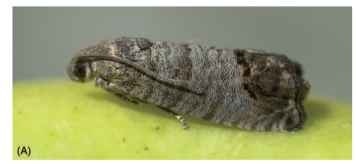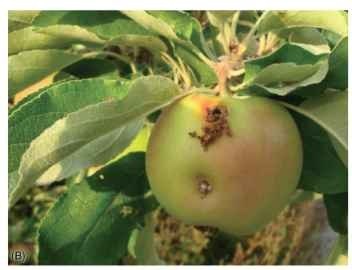Codling moth, Cydia pomonella (Fig. 1), is a key insect pest of apples, pears, and walnuts nearly worldwide. Codling moth acquired its name because of its attacks on a greenish, elongated English cooking apple referred to as a “codling” apple. The codling moth was noted to be a pest in Europe as early as 1635, well before the development of large-scale planting of apples or pears; the first report of codling moth in the United States was in 1750.

FIGURE 1 Codling moth (Cydia pomonella).

FIGURE 2 Codling moth-damaged apple.
IMPORTANCE AND DAMAGE
Codling moths spread from its presumed site of origin in Eurasia, along with the cultivation of its hosts, particularly apples; other agricultural hosts include quince, apricot, plum, peach, and nectarine, although codling moth is less of a problem in these crops. Damage results from shallow feeding wounds that cause scarring of the fruit, from direct feeding damage to the fruit pulp or seeds, or from indirect contamination of the fruit by larval feces (Fig. 2) .
LIFE HISTORY
Codling moth has between one and four generations per year, depending on temperature and other climatic factors. Adult codling moth females lay single eggs on the fruit or leaves of their host. Although some larvae feed on the surface of the fruit, most larvae bore directly into the fruit within 24 h, continue to feed briefly under the surface of the skin, and then move through the flesh of the fruit to feed on the seeds. There are five larval instars. Mature larvae exit the fruit and most frequently pupate under the bark. As daylength shortens with the approach of winter, mature fifth instars spin overwintering cocoons under bark, in debris, or in the ground at the base of the tree. The mature larvae spend the winter in a state of arrested development until spring conditions trigger development.
MANAGEMENT
Insecticides
Management of codling moth populations in orchards traditionally has relied on synthetic pesticides. Although newer, more selective pesticides provide effective control of codling moth, older pesticides have been associated with nontarget environmental and human health risks. In addition, the evolution of resistance in codling moth to many different groups of insecticides (the chlorinated hydrocarbons, organophosphates, carbamates, pyrethroids, newer insect growth regulators, and viruses) has made the long-term reliance on these compounds more problematic.
Pheromone Mating Disruption
A widespread alternative to insecticides relies on the disruption of codling moth mating using sex pheromones. Artificial emitters of the female attractant interfere with the male’s ability to find females. The most common dispensers are variations on different reservoir designs, which are tied or placed in orchard tree canopies. Synthetic pheromone from these emitters then permeates the orchard canopies. Although the exact mechanisms explaining this approach are unclear, program efficacy has been demonstrated in almost all growing regions of the world. However, mating disruption is often not efficacious initially in orchards with high pest densities, so that some use of conventional insecticides may be required. Mating disruption has been widely implemented with 160,000 hectares using this approach worldwide in 2006.
Biological Control
Although management of codling moth based on control by natural enemies has proven elusive, significant reductions in population densities have been made by using both native and introduced natural enemies of codling moth. A diverse complex of parasitoids, which varies by region and plant host, has been recorded attacking codling moth. One of the more thoroughly studied natural enemies is the Trichogramma egg parasitoid. Large numbers of these minute wasps are periodically released into an orchard to seek out and kill the eggs of codling moth. The eggs of Trichogramma are laid into the eggs of codling moth; the death of the egg occurs as the Trichogramma larvae develop. However, total parasitism levels by all parasitoids rarely reach more than 5%, except for some regions in central Asia where levels are as high as 50%. Nonspecialized parasitoids of egg, prepupal, or pupal stages comprise the majority of the natural enemies in North America; more specialized larval parasitoids are found in Europe and Central Asia.
General predators such as birds, predaceous insects, and spiders have been reported as suppressive agents of codling moth; these include woodpeckers, carabid beetles, and mirid bugs.
Although codling moth is susceptible to several diseases, a commercially available granulosis virus that can be applied in water, similar to insecticide applications, can cause significant reductions in codling moth densities. However, short residual activity of the virus often results in multiple applications being required. In addition, exposed larvae can sometimes live long enough to cause commercially unacceptable damage
